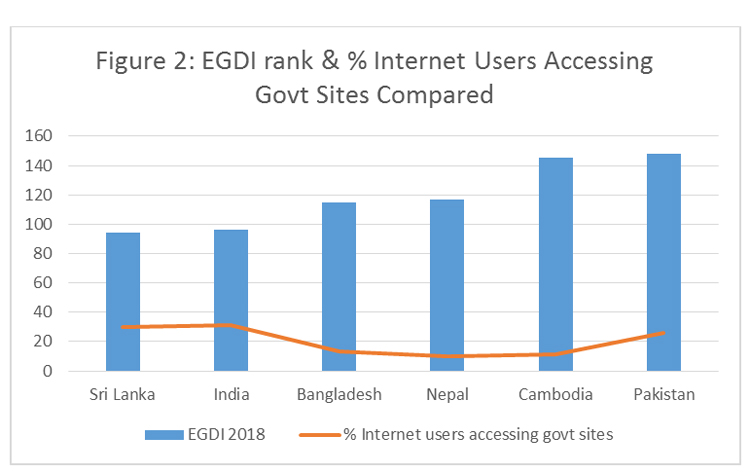October, 29, 2019

It is customary to assess an aspect of the performance of a country using a composite index such as the Ease of Doing Business Index or the Network Readiness Index. For government services, the indicator of choice is the e Government Development Index (EGDI), published every two years by the UN Department of Economic and Social Affairs.
Partly because of the complexity of the methodology, whereby the weights for different elements change with every iteration, and partly because some governments have begun to game the system, the rankings fluctuate quite a bit as shown by Figure 1. The directionality matters more than just the rank in a particular year.

Source: UN e Government Database
Sri Lanka is still the leader in the region, but barely. After a very significant advance in 2014, it is now just two places ahead of India. Bangladesh has been improving since 2014, advancing 27 positions in 10 years. However, Nepal which was eight places behind Bangladesh in 2008 was only two behind in 2018.
Absolute scores can increase, but ranks can go down. Ranks can increase, but another country can still overtake because it is doing even better.
Many countries such as those in the comparison set above are primarily focused on making government accessible to citizens on the web.
There seems to be simpler way of assessing the efficacy of these efforts. How many Internet users in a country access government websites? Figure 2 shows that the two indicators show similar results for the most part, except for Pakistan.
According to a recent nationwide sample survey by LIRNEasia of the 15-65 population in the countries depicted in the Figures, 30-31 percent of all Internet users in India and Sri Lanka access government information online, the highest percentage among the six countries. In the low performing countries as indicated by the EGDI, 10-13 percent of Internet users access government information online, except for the anomalous case of Pakistan where 26 percent of Internet users claim to have accessed government information.

Source: UN e Government Database & LIRNEasia
Except for the Pakistan anomaly, the simple indicator and the complex one tell the same tale.
What is interesting from a policy perspective is why those who have the means and the ability because they already are Internet users, still do not access government information online. Among those who do not access government websites, 71 percent say they do not know how to. Sixteen percent say they know how to access websites, but do not know where to go. The remainder, 13 percent, say they know how to access the information but see no value in it.
Almost one in twelve not knowing where to go is quite puzzling because of the existence of the government information portal, www.bangladesh.gov.bd. Convincing the 13 percent that there is real value in government information provided online should not be too difficult. The effort could actually yield larger benefits in terms of improving the quality and usability of the thousands of only services currently offered by the government. Reducing the percentage that says they do not know how to access government information is challenging, especially because they already know how to use the Internet.
In contrast, only 42 percent of Sri Lankan Internet users who do not access government services online say they do not know how to. Among the non-users, 30 percent know how, but see no value. Almost the same percentage, 28 percent, have trouble locating government information online. Sri Lanka does not have a government portal like Bangladesh. With some kind of aggregator or portal, that number may be reduced. As in Bangladesh, enhancing the value of online services and convincing the non-users can yield broad benefits.
Most users appear to be in the first stage of e gov. Very clearly, Bangladesh (like its peers) has much to do in the e government space. Surveys such as those conducted by LIRNEasia provide actionable insights on what to do to increase the number of citizens benefiting from e government services. This is a much more productive way to improve performance in the e Government Development Index, than appointing committees to game the process.
Video Story